Breathing Planet Earth: Analysis of Keeling’s Data on CO2 and O2 with Respiratory Quotient (RQ), Part II: Energy-Based Global RQ and CO2 Budget
Abstract
1. Introduction
2. Literature Review
2.1. CO2 Sources and O2 Sinks
2.2. CO2 Sinks and O2 Sources
2.3. Ocean CO2 Sinks and Ocean O2 Sources
2.4. Global Warming and Temperature
2.5. Research Gap
2.6. Overview of Part I
- (i)
- Respiratory Quotient (RQ):
- (ii)
- The literature on RQ and its relation to various terminologies in the photosynthesis literature were reviewed.
- (iii)
- (iv)
- The RQ concept was applied to fossil fuels (FFs) fired for power plants [45], and the relation between RQ and CO2 released in GT per Exa J was presented:where HHVO2 = 448 Exa J/Peta mole of O2, and MCO2 = 44.01 g/mole or 44.01 GT per Peta mole of CO2.
- (v)
- The Keeling’s data [46] on CO2 and O2 were used to obtain curve fit constants using linear and quadratic fits and present RQGlob as 0.47 (=d(CO2)/dt) in the atmosphere/ |d(O2)/dt| in the atmosphere), which is similar to ARQ in biology. Planet Earth behaves like a large BS, releasing 0.47 moles of CO2 to the atmosphere for every mole of O2 depleted from the atmosphere. The RQGlob is much less than the RQ of FFs due to CO2 sink by biomass and CO2 storage in the oceans.
- (vi)
- It was shown that the global RQGlob is a measure of the acidity of the oceans [9]. The lower the RQGlob is and the larger the difference between RQFF and RQGlob, the greater the acidity of the oceans.
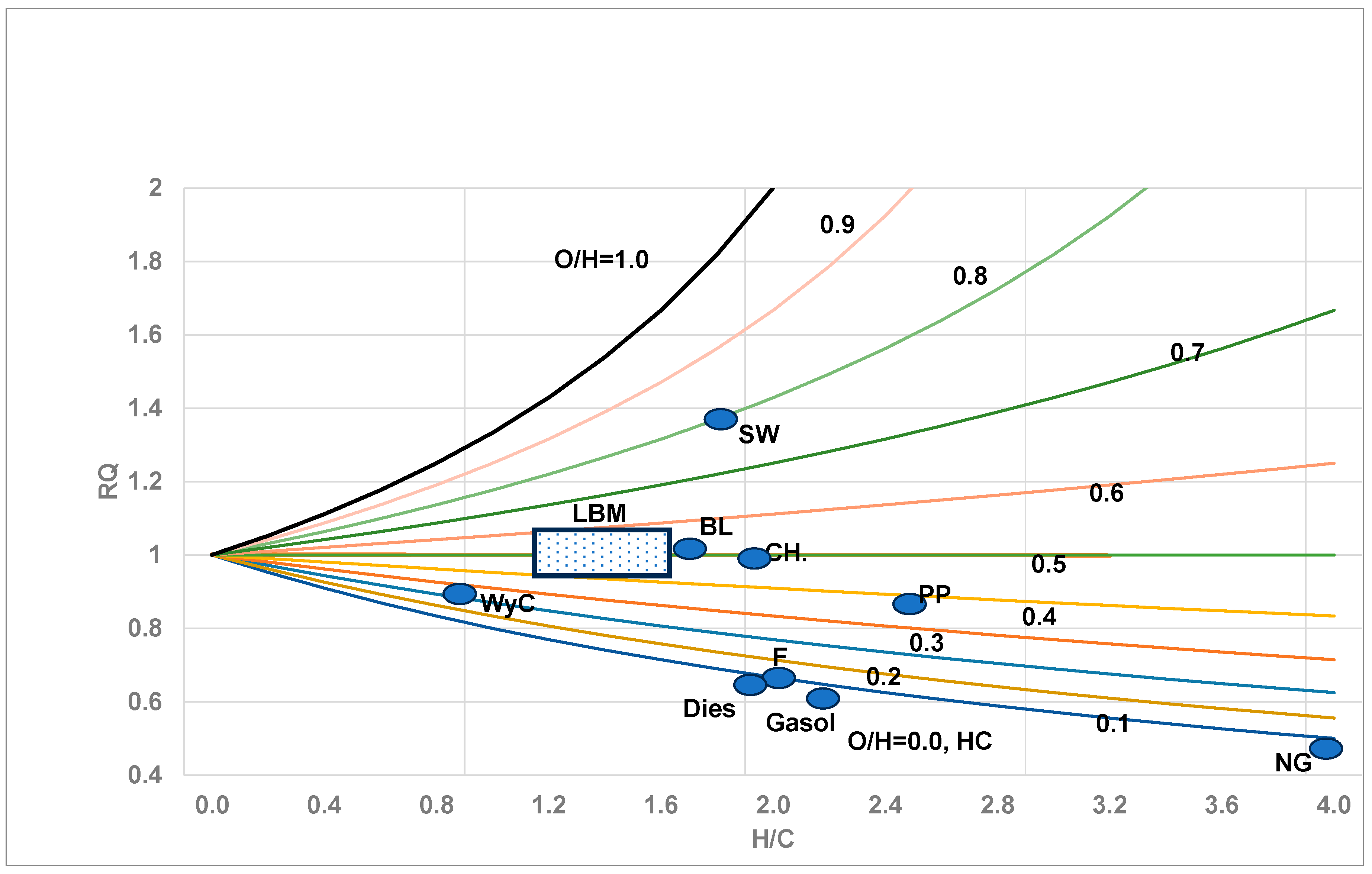
2.7. Objectives of Part II
3. Materials and Methods
3.1. Assumptions
- Humans and land and ocean-based animals consume renewable energy (not coal, oil, or fossil fuels), which presumes that the CO2 produced and O2 consumed by humans and animals is approximately equal to the CO2 sink and O2 production in growing “nutrient-crops”; they operate on “closed C” loop.
- Biomass includes terrestrial (land) and ocean water-based or marine biomass and micro-organisms.
- CO2 is released during calcination (cement making without using oxygen), and CO2 is used in limestone formations in the ocean (without the use of O2). It can be accounted for through the definition of an effective RQOWBM. Note that the C(s) from calcination (cement carbonation) is only 0.2 GT of C/year, while the CO2 storage in the ocean is 90 GT of C/year.
- While CO2 is stored, there is no net O2 storage in the oceans; there was only a 2% drop in ocean’s oxygen levels over the last 50 years [48], and hence, O2 storage in OW is neglected compared to CO2 since O2 in the atmosphere is at much higher concentrations and the ocean is nearly saturated with O2 due to much higher concentrations of O2 in the atmosphere compared to CO2 (note: solubility CO2: 0.0116 mL per L per mm Hg, O2: 0.00565 mL/L per mm Hg; typically, O2 saturation level in OW is about 7–8 mg/L, CO2 0.44–0.66 mg for warm to cold water; O2 saturation level is high due to the high concentration of O2 in the atmosphere}).
- Changes in O2 and CO2 storage due to changes in the temperature of ocean water are ignored in CO2 and O2 balance equations.
3.2. CO2 and O2 Balance Equations and Solutions for CO2 Distribution amongst Atmosphere, Land, and Ocean
- (i)
- CO2 Balance Equations
- (ii)
- O2 Balance Equation: see Huang et al. [25]:
- (iii)
- CO2 Source/Sink in Atmosphere in terms of RQ
3.3. Solutions for O2 Production, CO2 Storage in Ocean, and Carbon Budget
Solutions for O2 Production and CO2 Storage in Ocean
3.4. Global RQGlob and Energy-Based RQGlob(En)
| # | Variable | Linear Fit Numbers for 2006 in Parenthesis {} | Quadratic Fit (Also Called Parabolic Fit) Numbers for 2006 in Parenthesis { } |
|---|---|---|---|
| Curve Fit Constants and Slopes of Keeling’s curves on CO2 and O2 | |||
| 1 | Linear Fit of Keeling’s curve: CO2 in atmosphere, ppm | a1 * years + a0, linear fit {Est. CO2 for year 2006 = 381.7 ppm} [Keeling’s data 382.1 ppm] | c2 * years2 + c1 * years + c0, {CO2 for year 2006 = 380.5 ppm} [Keeling’s data 382.1 ppm] |
| 2 | O2 in atmosphere ppm | b1 * years + b0 {Est O2 for year 2006 = 209421.4 ppm} [Keeling’s data: 209,423 ppm] | d2 * years2 + d1 * years + d0,d2 = −0.0435 ppm/year2, d1 = −3.0332 ppm/year, {Est O2 for year 2006 = 209,424.6 ppm} [Keeling’s data: 209,423] |
| 3a | d[CO2]/d(year) = CO2 change per year, ppm in atmosphere /year | a1 {2.081 ppm/year, constant, independent of year} | 2 * c2 * years + c1 {2.04 ppm/year in 2006} |
| 3b | d (CO2)/d(year), GT/year 1 ppm of CO2 in atmosphere = 7.79 GT | 7.79 * a1 {16.2 in 2006, independent of year} [13.7 in 2006, 7% imbalance] | 7.79 * 2 * c2 * years + c1 {15.9 in 2006} [13.7 in 2006, 7% imbalance] |
| 4a | d[O2]/d(year), ppm/year 1 ppm of O2 in atmosphere = 5.66 GT | b1, negative {−4.44 ppm/year, constant, independent of year} | 2 * d2 * years + d1 {−4.34 ppm/year in 2006} |
| 4b | d(O2)/d(year)dO2/dt, GT removed from atmosphere/year | 5.66 |b1|, b1 in ppm/year {25.12 GT/year, constant and independent of year} | {24.59 GT/year in 2006} |
| Global RQ | |||
| 5 | , constant {0.468 constant, independent of year} | , decreases slightly with years, {0.470 in 2006} | |
| 6a | With Energy data, {d[CO2]/dt}, ppm/year | in Exa J/Year, a1, b1, ppm/year, FBal = 79.3 (see Table 4 for FBal relation) {0.358 in 2006} | in Exa J/Year, a1, b1, ppm/year {0.352 in 2006} |
| 6b | With C data in GT/year, {d[CO2]/dt}, ppm/year | (see Table 4 for FCGt relation) FCGt = 2.13, in GT/Year, a1, b1, ppm/year, {0.36 in 2006} | in GT/Year, a1, b1, ppm/year, {0.36 in 2006} |
| 6c | {d[CO2]/dt}, ppm/year | , | FCO2 = 0.0126 |
| Non-Dimensional Solutions for O2 Production and CO2 Storage in Ocean | |||
| 7a | , FBal = 79.3 {0.24 in year 2006 with FFLU Energy/year =460.1 Exa J/year} | {0.25 in year 2006} | |
| 7b | With C data | , carbon output GT/year by FFLU {0.24 with C data of 9.71 GT/year in 2006} | {0.26 in 2006} |
| 7c | Total O2 prod GT/year, LOWBM Combined Ocean and land biomasses | FO2BM * x * FO2BM = 0.0714 {7.72 GT/year in 2006 with x = 0.235} | FO2BM * x * , FO2BM = 0.0714 {8.25 GT/year in 2006 with x = 0.2516} |
| 8 | Ocean BM Contrib. O2 | z * x, where x for linear fit {0.024 in 2006 with z = 0.1} | z * x, where x for quadratic fit {0.025 in 2006 with z = 0.1} |
| 9 | Land BM Contrib. O2 | (1 − z) * x {0.21 in 2006 with z = 0.1} | (1 − z) * x, where x for quadratic fit {0.23 in 2006 with z = 0.1} |
| 10 | CO2 storage | Or {0.187} | Or {0.178} |
| CO2 Budget Amongst Atmosphere, Land, and Ocean | |||
| 11 | {0.46 in 2006} | {0.45 in 2006 } | |
| 12 | {0.30 in 2006} | {0.32 in 2006 } | |
| 13 | , {0.24 in 2006 with Energy data} | {0.23 in 2006 with Energy data} | |
| 14 | CO2 sink Fr via Ocean Biomass | , {0.030 in 2006} | {0.032 in 2006 with z = −0.1} |
| 15 | CO2 sink Fr Ocean Total | or {0.27 in 2006 with z = 0.1} [0.25 in 2006] | {0.26 in 2006 with z = −0.1} [0.25 in 2006] |
| 16 | CO2 sink Fr LBM | {0.27 in 2006 with z = 0.1} [0.33 in 2006 from data] | {0.29 in 2006 with z = 0.1} [0.33 in 2006 from data] |
| 17 | CO2 sink by land and ocean biomasses, GT/year | {10.5 GT/year in 2006} | {11.2 GT/year in 2006} |
| 18 | CO2 sink by ocean biomass, GT/year | z * CO2 sink by land and ocean biomasses in GT/year {1.05 GT/year in 2006 with z = −0.1} No previous data to compare | z * CO2 sink by land and ocean biomasses in GT/year {1.12 GT/year in 2006 with z = −0.1} No previous data to compare |
| 19 | CO2 sink by land biomass, GT/year | (1 − z) * CO2 sink by land and ocean biomasses in GT/year {9.45 GT/year in 2006 with z = −0.1} [11.06 GT/year in 2006] [28] | (1 − z) * CO2 sink by land and ocean biomasses in GT/year {10.08 GT/year in 2006 with z = −0.1} [11.06 GT/year in 2006] [28] |
| 20 | CO2 storage by ocean, GT/year | FCO2EJ * y * , FCO2EJ = MCO2/HHVO2 = 0.1 {8.63 GT/year in 2006} [8.36 GT/year in 2006] [50] | FCO2EJ * y * , FCO2EJ = MCO2/HHVO2 = 0.1 {8.21 GT/year} [8.36 (GT/year in 2006] [50] |
| Global Temperature and Earth’s Mass Loss | |||
| 21a | Global Temperature, °C vs. year | g1 * (year − 1991) + g0. | - |
| 21b | Global Temperature rise vs. CO2 of atmosphere in ppm. | = 355 ppm in 1991 {2006, T in °C = 12.17; Data 12.06 °C} | |
| 22a | Rate of Temperature rise per year, dT/d(year) in terms of Keeling’s data {d[CO2]/dt}, ppm/year, [CO2,0], ppm | 4 * (a1/a0) {1995 to 2022), dT/year = 0.024 °C /year} | Years = Year of interest—1991 {1995 to 2022, dT/year = 0.023 °C/year } |
| 22b | Rate of Temperature rise per year, dT/d (year) Energy data | ||
| 23 | Earth’s mass Loss Rate, GT/year | FCGTE * RQGlob(En) * , Alternate: FCGT * (d[CO2]/dt)qtm {4.42 GT/year, 2006} | FCGTE * RQGlob(En) * , Alternate: FCGT * (d[CO2]/dt)qtm {4.34 GT/year, 2006} |
| Source or Sink of Interest | RQ |
|---|---|
| Fossil Fuels, FFs | 0.75 |
| Land Use, LU | 1.0 |
| Combined FFs and LU | EFFF * RQFF + EFLU * RQLU = 0.778 |
| Land Biomass, LBM | 1.0 |
| Ocean water-based biomass, OWBM | 0.87 |
| Com Combined LBM + OWBM; | (1 − z) * RQLBM + (1 − z) * RQOWBM = 0.987 With z = 0.1 |
| Constants F | Relation | Value |
|---|---|---|
| FBal (item 6a, Table 2) | 10−6 * Nair * HHVO2 | 79.3 |
| FCGT (item 6b, Table 2) | FCGT = 10−6 * Nair * MC | 2.13 |
| FCEJ (item 7c, Table 2) | (MC/HHVO2) | 0.0268 |
| FCO2 | 0.0126 | |
| FCO2EJ (item 20, Table 2) | 0.1 | |
| FO2BM (item 7c, Table 2) | 0.0714 | |
| Fppm (item 17, Table 2) | 10−6 * Nair | 0.177 |
| FdTdt (Equation (36)) | , h1 = 4 |
3.4.1. CO2 Budget amongst Atmosphere, Land, and Ocean Biomasses and Ocean Storage
3.4.2. Data Used in Calculations
3.4.3. Literature Results on CO2 in Atmosphere, Land, and Ocean
4. Results and Discussion
4.1. Global Respiratory Quotients (RQGlob, RQGlob(En))
4.2. Normalized O2 Production (“x”) and CO2 Storage (“y”)
4.3. Earth’s Mass Loss, Earth’s Oxygen Concentration in the Future, and Tilt Angle
| O2, % (v) | Physiological Effects for Humans | Avg O2% (Predicted Year) | Cumulative Earth’s Mass Loss since 1991, GT (Year) |
|---|---|---|---|
| 21 | Normal | Avg O2% = 21, (1991) | 0 (1991) |
| 19.5 | Adverse effect, Oxygen-deficient | Avg O2% = 19.5, (2600) | 16,800 (2600) |
| 16–19 | Organ function fails, lack of coordination | Avg O2% = 17.5, (2900) | 36,100 (2900) |
| 12–16 | tachypnea (increased breathing rates), tachycardia (accelerated heartbeat), | Avg O2% = 14.0 (3250) | 67,700 (3250) |
| 10–14 | intermittent respiration, vomiting | Avg O2% = 12.0 (3400) | 84,300 (3400) |
| 6–10 | Lethal level of O2 at 62 millibar {called Armstrong limit at 6% sea level pressure}. Loss of consciousness, organ damage | Avg O2% = 8.0 (3700) | 123,000 (3700) |
4.4. CO2 Budget for Year 2006
4.4.1. O2 Production by Land and Controversy on O2 Transfer from Ocean to Atmosphere and z Factor
4.4.2. Effects of z on CO2 Sink by LBM, OWBM, and Ocean Storage
- The results for CO2 sink in the atmosphere are not affected by z.
- The ocean CO2 storage is close to the reported data literature for all z (z = 0, 0.1, 0.5) and is a weak function of “z”. The reasons are as follows: the O2 production by biomass is the difference between O2 consumption by FFLU and actual O2 removed from the atmosphere. Thus, once O2 production is determined, the RQLOWBM of combined biomass from the land and ocean determines the amount of CO2 sink, which is O2 production * RQLOWBM. The RQLOWBM of combined biomasses is a weak function of z. The CO2 balance dictates that the CO2 storage (= CO2 produced by FFLU − CO2 sinks via combined land and ocean biomass) is a weak function of z.
- There is a budget imbalance % in the previous literature data on C or CO2, which is given as [(FFLU CO2 source − CO2 added to the atmosphere − CO2 used by both land and ocean biomasses − CO2 stored by ocean water) * 100/ FFLU CO2 source]. The imbalance is about 7% [50]. For example, the CO2 added to the atmosphere is 15.9 GT/year, while data provided by the “stand-alone” atmosphere models indicate only 13.7 GT/year. However, the current formulation with the RQ method is based on the CO2 or C balance method, i.e., the literature data reported on CO2 must be increased by 7%, or data for atmosphere must be increased to 14.7 GT/year when compared with results from the RQ model.
- All the numbers were cross-checked by starting from the end results and back-calculating Keeling’s data (ppm of CO2 added to the atmosphere and ppm O2 removed from the atmosphere) for the following cases. (i) First estimate the ppm of CO2 added to the atmosphere and O2 removed from the atmosphere due to FFLU alone, in case there was no biomass or ocean storage in 2006; (ii) Then, estimate the ppm of CO2 removed and O2 produced by land and ocean biomasses (based on results for CO2% removed by land and ocean biomasses) and re-calculate the ppm of CO2 added to the atmosphere and O2 depleted from the atmosphere. (iii) Finally, estimate the ppm of CO2 removed due to storage by ocean water (based on % CO2 stored by ocean water) and calculate the CO2 added to the atmosphere. (iv) Verify these numbers (ppm/year) to be the same as Keeling’s data on CO2 and O2.
- Using the formula listed Table 2, the CO2 fractions in the atmosphere, land and ocean BM, and ocean storage {Rows 11, 12 and 13} and the CO2 loading in GT/year are estimated {Rows 3b,17 and 20}. The sum of the CO2 fraction in the atmosphere, land and ocean BM, and ocean storage was confirmed to be in unity.
- The RQ method with a quadratic fit for land CO2 sink is estimated as 10.3 GT/year at z = 0.1, while the reported data are 11.1 GT/year. The results from the RQ method agree closely with the literature data on CO2 sink by LBM at low values of z (0 < z < 0.1).
- Since RQOWBM = 0.87, RQLBM = 1, then for z = 0.1, RQLOWBM = 0.987 ≈ RQLBM (since 90% O2 added to atm is assumed to come from LBM).
- When z = 0.5 (50% O2 by ocean biomass or 50% CO2 by land biomass), the RQ method underpredicts the CO2 sink by land biomass since the % of O2 production by land biomass is reduced with a corresponding reduction in CO2 sink at a fixed RQLBM.
- When the explicit formula (Equation (14) to Equation (16)) was used for the year 2006 with z = 0.1, CO2 atmosphere % =45.2 (literature: 41.3), CO2 land BM % = 29.04 (29.2), and (Ocn st + Ocn BM), % = 25.7 (25.3).
4.5. Comparison of Annual CO2 from RQ Method with the Reported Annual Data (1991–2020)
4.5.1. Freezing CO2 Growth in Atmosphere Using RQ
4.5.2. Freezing CO2 Growth in Atmosphere by CO2 Storage
4.6. Relation between Global Temperature, Rate of Heating, Energy, and Global CO2 Concentration

4.7. Limitation of Results
4.8. Policies and Econometry
5. Summary
6. Future Work
Supplementary Materials
Funding
Data Availability Statement
Acknowledgments
Conflicts of Interest
Nomenclature
| AFFLUE | Annual Fossil and Land Use Energy |
| AI | Artificial Intelligence |
| ARQ | Apparent Respiration Quotient |
| BS | Biological system |
| Carbon release rate, GT/year | |
| CCP | Coal Combustion Project |
| CE | Carbon Emission |
| CH | Carbohydrate |
| CS | Carbon storage |
| CO2eq | CO2 equivalent |
| DAF | Dry ash free |
| Energy release rate from FFLU, Exa J/year | |
| EF | Energy fraction |
| EPA | Environmental Protection Agency |
| EPICA | European Project for Ice Coring in Antarctica |
| Exa g | 1018 g = 1000 Peta g or 1000 Giga tons or 1000 billion tons = 106 Tera g = 109 Giga g = 1012 Mega g = 1015 kg |
| ExR | Exchange ratio = 1/RQ |
| F | Fat |
| Fi | constants used in many relations; Table 4 lists them. |
| FF | Fossil Fuel |
| FFLU | Fossil fuel and Land use |
| GCP | Global Carbon Project |
| GPP | Gross Primary Production |
| GWP | Global warming Potentia-CO2 eq GWP100: GWP over 100 years |
| HBS | Hypothetical biological System |
| HH | Hypothetical Human |
| HHVO2 | Energy released per Peta Mol of O2 = 448 Exa J per Peta mol of O2 |
| IPCC | Inter-government Panel on Climate Change |
| LBM | Land biomass |
| LOWBM | Combined land and ocean water biomasses |
| LU | Land use |
| M | Molecular weight |
| MOM | Marine organic matter |
| Mole rates of CO2, O2 per year | |
| CO2 release rate from FFLU and O2 consumption by FFLU, Peta moles/year | |
| NBS | Non-biological systems |
| NEP | Net Ecosystem Production, NEP = NPP − Loss due to Dead Matter |
| NG | Natural gas |
| NH | Normal Human |
| NOAA | National Oceanic and Atmospheric Administration |
| NPP | Net Primary Product, NPP = GPP − Respiration Rate_ |
| OW | Ocean water |
| OWBM | Ocean water biomass |
| Per meg | 1 molecule out of 1000,000 oxygen molecules, 1 ppm in air = 4.76 per meg |
| PP | Phytoplankton |
| ppb | parts per billion |
| ppm | parts per million or molecules per million molecules 1 ppm in atmosphere = 7.77 GT for CO2, 2.12 GT for C, 1 ppm O2 in atmosphere = 5.65 GT |
| PQ | Photo-synthetic quotient, = 1/RQ |
| Quad BTU | 1015 BTU |
| RQ | Respiratory quotient |
| RQGlob | Global RQ based on Keeling’s data on CO2 and O2, (d[CO2]/dt)/(d[O2]/dt) |
| RQGlob(En) | Energy based Global RQ = Ratio of moles of CO2 release and O2 consumption by FFLU |
| RR | Redfield ratio = 1/RQ |
| SDG | Sustainable development goal |
| SST | Sea surface temperature |
| UCF | Unit carbon formula |
| Yk | mass fraction of element k, g of k/g of mixture |
| ZJ | Zetta joule, 1021 J |
| [k] | Species k in moles or ppm per unit volume |
Appendix A. CO2 Added to Atmosphere and O2 Removed from Atmosphere in GT per Year
- (a)
- CO2 added to the atmosphere.where Nair = 1.77 × 105 Peta moles. Generally for any trace GHG of molecular weight MGHG
- (b)
- O2 Removed from Atmosphere
Appendix B. CO2 and O2 Balance Equations in Non-Dimensional Form and Solutions for O2 Production by Land Ocean Biomasses and CO2 Storage by Ocean
Appendix C. Estimation of “Z” (O2 Transferred from Ocean to Atm /Total O2 Produced) from C Sink on Land and C Emission
- Estimate the rate of decrease in O2 from the atmosphere from Keeling’s data.
- Use left-hand side of Equation (A8) to determine “x” ratio of O2 produced to O2 used by FFs and LU.
- Since the ratio of O2 production by land to total O2 production is (1 − z) * x and since O2 production is for every mole of C(s) or CO2 sink, then O2 production via land in Peta mole/year = (1 − z) * x * (annual O2 sink in Peta moles due to FFLU) = CO2 or C(s) sink on land in Peta moles on land per year = C(s) sink on land (GT/year) * 1015 (g/GT) /{RQBM * MC (g/mol) * 1015 (mole/Peta mole)} = C(s) sink on land (GT/year)/({RQBM * MC g/mol)}.
- A formula for z can be derived as follows:where O2 sinks due to FFLU, Peta moles/year = (C emission in FFLU in (GT/year)/(RQFFLU * MC), and MC = 12.01.
References
- Duursma, E.K.; Boisson, M.P. Global Oceanic and Atmospheric Oxygen. Oceanol. Acta 1994, 17, 117–141. [Google Scholar]
- Schmiege, S.C.; Heskel, M.; Fan, Y.; Way, D.A. It’s only natural: Plant respiration in unmanaged systems. Plant Physiol. 2023, 192, 710–727. [Google Scholar] [CrossRef]
- Pries, H.C.P.; Angert, A.; Castanha, C.; Hilman, B.; Torn, M.S. Using respiration quotients to track changing sources of soil respiration seasonally and with experimental warming. J. Biogeoscience 2020, 17, 3045–3055. Available online: https://bg.copernicus.org/articles (accessed on 28 January 2024). [CrossRef]
- Feely, R.A.; Sabine, C.L.; Takahashi, T.; Wanninkhof, R. Uptake and Storage of Carbon Dioxide in the Ocean: The Global CO2 Survey. JGOFS Oceanogr. 2001, 14, 18–32. [Google Scholar] [CrossRef]
- Gruber, N.; Gloor, M.; Fan, S.-M.; Sarmiento, J.L. Air-sea flux of oxygen estimated from bulk data: Implications for the marine and atmospheric oxygen cycles. Glob. Biogeochem. Cycles 2001, 15, 783–803. [Google Scholar] [CrossRef]
- Mehmood, T.; Hassan, M.A.; Li, X.; Ashraf, A.; Rehman, S.; Bilal, M.; Obodo, R.M.; Mustafa, B.; Shaz, M.; Bibi, S.; et al. Mechanism behind Sources and Sinks of Major Anthropogenic Greenhouse Gases, Climate Change Alleviation for Sustainable Progression; CRC Press: Boca Raton, FL, USA, 2022; Chapter 8; ISBN 9781003106982. [Google Scholar]
- U.S. EPA. 2020 Common Reporting Format (CRF); U.S. EPA Environmental Protection Agency: Washington, DC, USA, 2020.
- Gasser, T.; Crepin, L.; Quilcaille, Y.; Houghton, R.A.; Ciais, P.; Obersteiner, M. Historical CO2 emissions from land use and land cover change and their uncertainty. Biogeosciences 2020, 17, 4075–4101. [Google Scholar] [CrossRef]
- Annamalai, K. Breathing Planet Earth: Global Respiratory Quotient (RQGlob) from Keeling’s Data and CO2-Budget among the Atmosphere, Land and Oceans, Part I: Brief Review on RQ and Global Respiratory Quotient of Earth. J. Energy 2023, 17, 299. [Google Scholar]
- Available online: https://www.theguardian.com/commentisfree/2008/aug/13/carbonemissions.climatechange (accessed on 1 January 2024).
- Martin, D.; McKenna, H.; Livina, V. The human physiological impact of global deoxygenation. J. Physiol. Sci. 2017, 67, 97–106. [Google Scholar] [CrossRef]
- Livina, V.N.; Martins, T.M.; Forbes, A.B. Tipping point analysis of atmospheric oxygen concentration. Chaos 2015, 25, 036403. [Google Scholar] [CrossRef]
- Available online: https://news.climate.columbia.edu/2022/01/27/how-climate-change-will-affect-plants/ (accessed on 7 December 2023).
- Available online: https://en.wikipedia.org/wiki/Composition_of_the_human_body (accessed on 25 August 2023).
- Available online: https://ourworldindata.org/life-by-environment (accessed on 14 January 2023).
- Gruber, N.; Clement, D.; Carter, B.R.; Feely, R.A.; van Heuven, S.; Hoppema, M.; Ishii, M.; Key, R.M.; Kozyr, A.; Lauvset, S.K.; et al. The oceanic sink for anthropogenic CO2 from 1994 to 2007. Science 2019, 363, 1193–1199. [Google Scholar] [CrossRef]
- Falkowski, P.G. The role of phytoplankton photosynthesis in global biogeochemical cycles. Photosynth. Res. 1994, 39, 235–258. [Google Scholar] [CrossRef]
- Available online: https://socratic.org/questions/55c2531d581e2a136c45b148 (accessed on 28 January 2024).
- Behrenfeld, M.J. Climate-mediated dance of the plankton. Nat. Clim. Chang. 2014, 4, 880–887. [Google Scholar] [CrossRef]
- Available online: https://mynasadata.larc.nasa.gov/basic-page/global-phytoplankton-distribution (accessed on 15 April 2023).
- Available online: https://ugc.berkeley.edu/background-content/oxygen-levels/ (accessed on 15 January 2024).
- Zhao, R.; Zhang, I.H.; Jayakumar, A.; Ward, B.B.; Babbin, A.R. Origin, age, and metabolisms of dominant anammox bacteria in the global oxygen deficient zones. bioRxiv 2023. [Google Scholar] [CrossRef]
- Available online: https://theconversation.com/humans-will-always-have-oxygen-to-breathe-but-we-cant-say-the-same-for-ocean-life-165148 (accessed on 6 February 2023).
- Balkanski, Y.; Monfray, P.; Battle, M.; Heimann, M. Ocean primary production derived from satellite data: An evaluation with atmospheric oxygen measurements. Glob. Biogeochem. Cycles 1999, 13, 257–271. [Google Scholar] [CrossRef]
- Huang, J.; Huang, J.; Liu, X.; Li, C.; Ding, L.; Yu, H. The global oxygen budget and its future projection. Sci. Bull. 2018, 63, 1180–1186. [Google Scholar] [CrossRef]
- Long, M.C.; Ito, T.; Deutsch, C. Oxygen projections for the future. In Ocean Deoxygenation: Everyone’s Problem—Causes, Impacts, Consequences and Solutions; Laffoley, D., Baxter, J.M., Eds.; IUCN: Gland, Switzerland, 2019; Chapter 4; pp. 171–211, xxii+56. [Google Scholar]
- Keeling, R.F.; Manning, A.C. Studies of Recent Changes in Studies of Recent Changes in Atmospheric O2 Content. In Treatise on Geochemistry, 2nd ed.; Holland, H.D., Turekian, K.K., Eds.; Elsevier: Amsterdam, The Netherlands, 2014; pp. 385–404. [Google Scholar] [CrossRef]
- Tohjima, Y.; Mukai, H.; Machida, T.; Hoshina, Y.; Nakaoka, S. Global carbon budgets estimated from atmospheric O2/N2 and CO2 observations in the western Pacific region over a 15-year period. Atmos. Chem. Phys. 2019, 19, 9269–9285. [Google Scholar] [CrossRef]
- Webb, P. Introduction to Oceanography; Chapter 5, Digital Book; Rebus Community: Montreal, Quebec, Canada. Available online: https://rwu.pressbooks.pub/webboceanography (accessed on 28 January 2024).
- Available online: https://newportbay.org/ask-a-naturalist-do-phytoplankton-produce-more-oxygen-than-a-rainforest-if-so-does-the-oxygen-they-produce-go-into-the-atmosphere-or-does-it-just-remain-dissolved-in-the-ocean/ (accessed on 26 February 2023).
- Lenssen, N.; Schmidt, G.; Hansen, J.; Menne, M.; Persin, A.; Ruedy, R.; Zyss, D. Improvements in the GISTEMP uncertainty model. J. Geophys. Res. Atmos. 2018, 124, 6307–6326. [Google Scholar] [CrossRef]
- Available online: https://climatedataguide.ucar.edu/climate-data/global-temperature-data-sets-overview-comparison-table (accessed on 31 July 2023).
- Hansen, J.; Ruedy, R.; Sato, M.; Lo, K. Global surface temperature change. Rev. Geophys. 2010, 48, RG4004. [Google Scholar] [CrossRef]
- NOAA; National Centers for Environmental Information. State of the Climate: Global Climate Report for 2022. 2023. Available online: https://www.ncei.noaa.gov/access/monitoring/monthly-report/global/202213 (accessed on 28 January 2024).
- Available online: https://www.climate.gov/news-features/understanding-climate/international-report-2021-climate-record-high-greenhouse-gases (accessed on 12 September 2023).
- Chaisson, E.J. Long-Term Global Heating from Energy Usage. Eos Trans. AGU 2008, 89, 253–254. [Google Scholar] [CrossRef]
- Schuckmann, K.; Minère, A.; Gues, F.; Cuesta-Valero, F.J.; Kirchengast, G.; Adusumilli, S.; Straneo, F.; Ablain, M.; Allan, R.P.; Barker, P.M.; et al. Heat stored in the Earth system 1960–2020: Where does the energy go? J. Earth Syst. Sci. Data 2023, 15, 1675–1709. [Google Scholar] [CrossRef]
- Available online: https://www.ncei.noaa.gov/access/monitoring/monthly-report/global/202303 (accessed on 7 June 2023).
- Available online: https://www.un.org/development/desa/jpo/wp-content/uploads/sites/55/2017/02/2030-Agenda-for-Sustainable-Development-KCSD-Primer-new.pdf (accessed on 15 February 2024).
- Available online: https://www.ipcc.ch/sr15/ (accessed on 1 February 2024).
- Kim, S.K.; Shin, J.; An, S.I.; Kim, H.J.; Im, N.; Xie, S.P.; Kug, J.S.; Yeh, S.W. Widespread irreversible changes in surface temperature and precipitation in response to CO2 forcing. Nat. Clim. Chang. 2022, 12, 834–840. [Google Scholar] [CrossRef]
- Duffy, K.A.; Schwalm, C.R.; Arcus, V.L.; Koch, G.W.; Liang, L.L.; Schipper, L.A. How close are we to the temperature tipping point of the terrestrial biosphere? Sci. Adv. 2021, 7, eaay1052. [Google Scholar] [CrossRef]
- Available online: https://climate.mit.edu/ask-mit/how-will-future-warming-and-co2-emissions-affect-oxygen-concentrations (accessed on 15 January 2024).
- Friedlingstein, P.; O’sullivan, M.; Jones, M.W.; Andrew, R.M.; Gregor, L.; Hauck, J.; Quéré, C.L.; Luijkx, I.T.; Olsen, A.; Peters, G.P.; et al. Global Carbon Budget 2022. Earth Syst. Sci. Data 2022, 14, 4811–4900. [Google Scholar] [CrossRef]
- Thanapal, S.S.; Annamalai, K.; Lawrence, B.; Sweeten, J.M. Biomass Co-Combustion with Coal. In Reference Module in Earth Systems and Environmental Sciences; Elsevier: Amsterdam, The Netherlands, 2023; ISBN 9780124095489. [Google Scholar] [CrossRef]
- Keeling, C.D.; Piper, S.C.; Bacastow, R.B.; Wahlen, M.; Whorf, T.P.; Heimann, M.; Meijer, H.A. Atmospheric CO2 and 13CO2 Exchange with the Terrestrial Biosphere and Oceans from 1978 to 2000: Observations and Carbon Cycle Implications. In A History of Atmospheric CO2 and Its Effects on Plants, Animals, and Ecosystems; Ecological Studies; Springer: New York, NY, USA, 2005; Volume 177, pp. 83–113. [Google Scholar] [CrossRef]
- Annamalai, K.; Thanapal, S.; Ranjan, D. Ranking renewable and fossil fuels on global warming potential using respiratory quotient (RQ) Concept. J. Combust. 2018, 2018, 1270708. [Google Scholar] [CrossRef]
- Schmidtko, S.; Stramma, L.; Visbeck, M. Decline in global oxygen content during the past five decades. Nature 2017, 542, 335–339. [Google Scholar] [CrossRef]
- Energy Institute. Energy Institute—Statistical Review of World Energy-with Major Processing by Our World in Data. Other Renewables (Including Geothermal and Biomass). 2023. Available online: https://ourworldindata.org/energy-mix (accessed on 21 February 2024).
- Available online: https://github.com/openclimatedata/global-carbon-budget/blob/main/data/global-carbon-budget.csv#L2 (accessed on 21 February 2024).
- Moreno, A.R.; Larkin, A.A.; Lee, J.A.; Gerace, S.D.; Tarran, G.A.; Martiny, A.C. Regulation of the respiration quotient across ocean basins. AGU Adv. 2022, 3, e2022AV000679. [Google Scholar] [CrossRef]
- Severinghaus, J.P. Studies of the Terrestrial O2 and Carbon Cycles in Sand Dune Gases and in Biosphere 2. Ph.D. Dissertation, Columbia University, New York, NY, USA, 1995. [Google Scholar]
- Dlugokencky, E.; Tans, P. Trends in atmospheric carbon dioxide, National Oceanic & Atmospheric Administration. Earth System Research Laboratory (NOAA/ESRL). Available online: http://www.esrl.noaa.gov/gmd/ccgg/trends/global.html (accessed on 21 February 2024).
- Hansis, E.; Davis, S.J.; Pongratz, J. Relevance of methodological choices for accounting of land use change carbon fluxes. Glob. Biogeochem. Cycles 2015, 29, 1230–1246. [Google Scholar] [CrossRef]
- Available online: https://www.co2.earth/co2-acceleration (accessed on 12 September 2023).
- Annamalai, K.; Nanda, A. Biological aging and life span based on entropy stress via organ and mitochondrial metabolic loading. Entropy 2017, 19, 566. [Google Scholar] [CrossRef]
- Gilfillan, D.; Marland, G.; Boden, T.; Andres, R. Global, Regional, and National Fossil-Fuel CO2 Emissions. Available online: https://energy.appstate.edu/CDIAC (accessed on 2 May 2023).
- Houghton, R.A.; Nassikas, A.A.; Hansis, E.; Davis, S.J.; Pongratz, J. Releva average of two bookkeeping models: Global and regional fluxes of carbon from land use and land cover change 1850–2015. Glob. Biogeochem. Cycles 2017, 31, 456–472. [Google Scholar] [CrossRef]
- Available online: https://ourworldindata.org/fossil-fuels#global-fossil-fuel-consumption (accessed on 28 January 2024).
- Gardner, A.; Ellsworth, D.S.; Crous, K.Y.; Pritchard, J.; MacKenzie, A.R. Is photosynthetic enhancement sustained through three years of elevated CO2 exposure in 175-year-old Quercus robur? Tree Physiol. 2022, 42, 130–144. [Google Scholar] [CrossRef]
- Mo, L.; Zohner, C.M.; Reich, P.B.; Liang, J.; de Miguel, S.; Nabuurs, G.-J.; Renner, S.S.; Hoogen, J.v.D.; Araza, A.; Herold, M.; et al. Integrated global assessment of the natural forest carbon potential. Nature 2023, 624, 92–101. [Google Scholar] [CrossRef]
- Available online: https://www.osha.gov/laws-regs/standardinterpretations/2007-04-02-0#:~:text=Paragraph%20(d)(2)(,dangerous%20to%20life%20or%20health (accessed on 14 February 2024).
- Seo, K.; Ryu, D.; Eom, J.; Jeon, T.; Kim, J.; Youm, K.; Chen, J.; Wilson, C.R. Drift of Earth’s Pole Confirms Groundwater Depletion as a Significant Contributor to Global Sea Level Rise 1993–2010. Geophys. Res. Lett. 2023, 50, 1215. [Google Scholar] [CrossRef]
- Available online: https://www.space.com/earth-tilt-changed-by-groundwater-pumping (accessed on 11 August 2023).
- Karl, D.M.; Laws, E.A.; Morris, P.; Williams, P.J.; Le, B.; Emerson, S. Metabolic balance in the open sea. Nature 2003, 426, 32. [Google Scholar] [CrossRef]
- Najjar, R.G.; Keeling, R.F. Mean annual cycle of the air-sea oxygen flux: A global view. Glob. Biogeochem. Cycles 2000, 14, 573–584. [Google Scholar] [CrossRef]
- del Giorgio, P.A.; Duarte, C.M. Respiration in the open ocean. Nature 2002, 420, 379–384. [Google Scholar] [CrossRef]
- Available online: https://www.un.org/en/climatechange/science/climate-issues/ocean#:~:text=The%20ocean%20generates%2050%20percent,the%20impacts%20of%20climate%20change (accessed on 15 February 2023).
- Lindsey, R.; Scott, M. What are Phytoplankton? 2010. Available online: https://earthobservatory.nasa.gov/features/Phytoplankton (accessed on 6 February 2023).
- Available online: https://oceanservice.noaa.gov/facts/ocean-oxygen.html (accessed on 24 February 2024).
- Land Use, Land-Use Change, and Forestry, A Special Report of the Intergovernmental Panel on Climate Change; IPCC Special Report, Summary for Policy Makers Secretary; General World Meteorological Organization: Montreal, QC, Canada, 2000; ISBN 92-9169-114-3.
- Bonan, G.B. Forests and climate change: Forcings, feedback, and the climate benefits of forests. Science 2008, 320, 1444–1449. [Google Scholar] [CrossRef]
- Rosenberg, G.; Littler, D.S.; Littler, M.M.; Oliveira, E.C. Primary production and photosynthetic quotients of seaweeds from Sao Paulo State, Brazil. Bot. Mar. 1995, 39, 369–377. [Google Scholar] [CrossRef]
- May, M.; Rehfeld, K. Negative Emissions as the New Frontier of Photoelectrochemical CO2 Reduction. Adv. Energy Mater. 2022, 12, 2103801. [Google Scholar] [CrossRef]
- Urych, T.; Chećko, J.; Magdziarczyk, M.; Smoliński, A. Numerical Simulations of Carbon Dioxide Storage in Selected Geological Structures in North-Western Poland. Carbon Capture, Utilization and Storage. Front. Energy Res. 2022, 10, 827794. [Google Scholar] [CrossRef]
- Xue, W.; Wang, Y.; Chen, Z.; Liu, H. An integrated model with stable numerical methods for fractured underground gas storage. J. Clean. Prod. 2023, 393, 136268. [Google Scholar] [CrossRef]
- Available online: https://earthobservatory.nasa.gov/world-of-change/global-temperatures (accessed on 12 September 2023).
- Available online: https://earthobservatory.nasa.gov/world-of-change/decadaltemp.php (accessed on 20 January 2024).
- Available online: https://earthobservatory.nasa.gov/world-of-change/global-temperatures#:~:text=The%20data%20reflect%20how%20much,several%20tenths%20of%20a%20degree (accessed on 2 January 2024).
- Samset, B.H.; Zhou, C.; Fuglestvedt, J.S.; Lund, M.T.; Marotzke, J.; Zelinka, M.D. Steady global surface warming from 1973 to 2022 but increased warming rate after 1990. Commun. Earth Environ. 2023, 4, 400. [Google Scholar] [CrossRef]
- Hansen, J.; Sato, M. Global Temperature in 2021, July Temperature Update: Faustian Payment Comes Due. Available online: https://www.columbia.edu/jeh1 (accessed on 13 August 2021).
- Available online: https://www.weather.gov/media/slc/ClimateBook/Annual%20Average%20Temperature%20By%20Year.pdf (accessed on 28 January 2024).
- Available online: https://www.chegg.com/homework-help/questions-and-answers/536-511-ear-nyc-temperature-1870-1871-1872-1873-1874-1875-1876-1877-1878-1879-1880-1881-18-q73111012 (accessed on 28 January 2024).
- Fraas, A.G.; Graham, J.D.; Krutilla, K.M.; Lutter, R.; Shogren, J.F.; Thunström, L.; Viscusi, W.K. Seven Recommendations for Pricing Greenhouse Gas Emissions. J. Benefit-Cost Anal. 2023, 14, 191–204. [Google Scholar] [CrossRef]
- Andersson, J.J. Carbon Taxes and CO2 Emissions: Sweden as a Case Study. Am. Econ. J. Econ. Policy 2019, 11, 1–30. [Google Scholar] [CrossRef]
- Gowd, S.C.; Ganeshan, P.; Vigneswaran, V.S.; Hossain, M.S.; Kumar, D.; Rajendran, K.; Ngo, H.H.; Pugazhendhi, A. Economic perspectives and policy insights on carbon capture, storage, and utilization for sustainable development. Sci. Total Environ. 2023, 883, 163656. [Google Scholar] [CrossRef]
- Available online: https://sgp.fas.org/crs/misc/IF11455.pdf (accessed on 14 January 2024).
- Dindi, A.; Coddington, K.; Garofalo, J.F.; Wu, W.; Zhai, H. Policy-Driven Potential for Deploying Carbon Capture and Sequestration in a Fossil-Rich Power Sector. Environ. Sci. Technol. 2022, 56, 9872–9881. [Google Scholar] [CrossRef]
- Thanapal, S. (Former Texas A&M PhD student and with Energy Company). Personal communication, 2023.
- Treydte, K.; Liu, L.; Padrón, R.S.; Martínez-Sancho, E.; Babst, F.; Frank, D.C.; Gessler, A.; Kahmen, A.; Poulter, B.; Seneviratne, S.I.; et al. Recent human-induced atmospheric drying across Europe has been unprecedented in the last 400 years. Nat. Geosci. 2023, 17, 58–65. [Google Scholar] [CrossRef]
- Van Noorden, R. “Artificial Leaf” faces economic hurdle. Nature 2012, S2CID 211729746, 10703. [Google Scholar] [CrossRef]

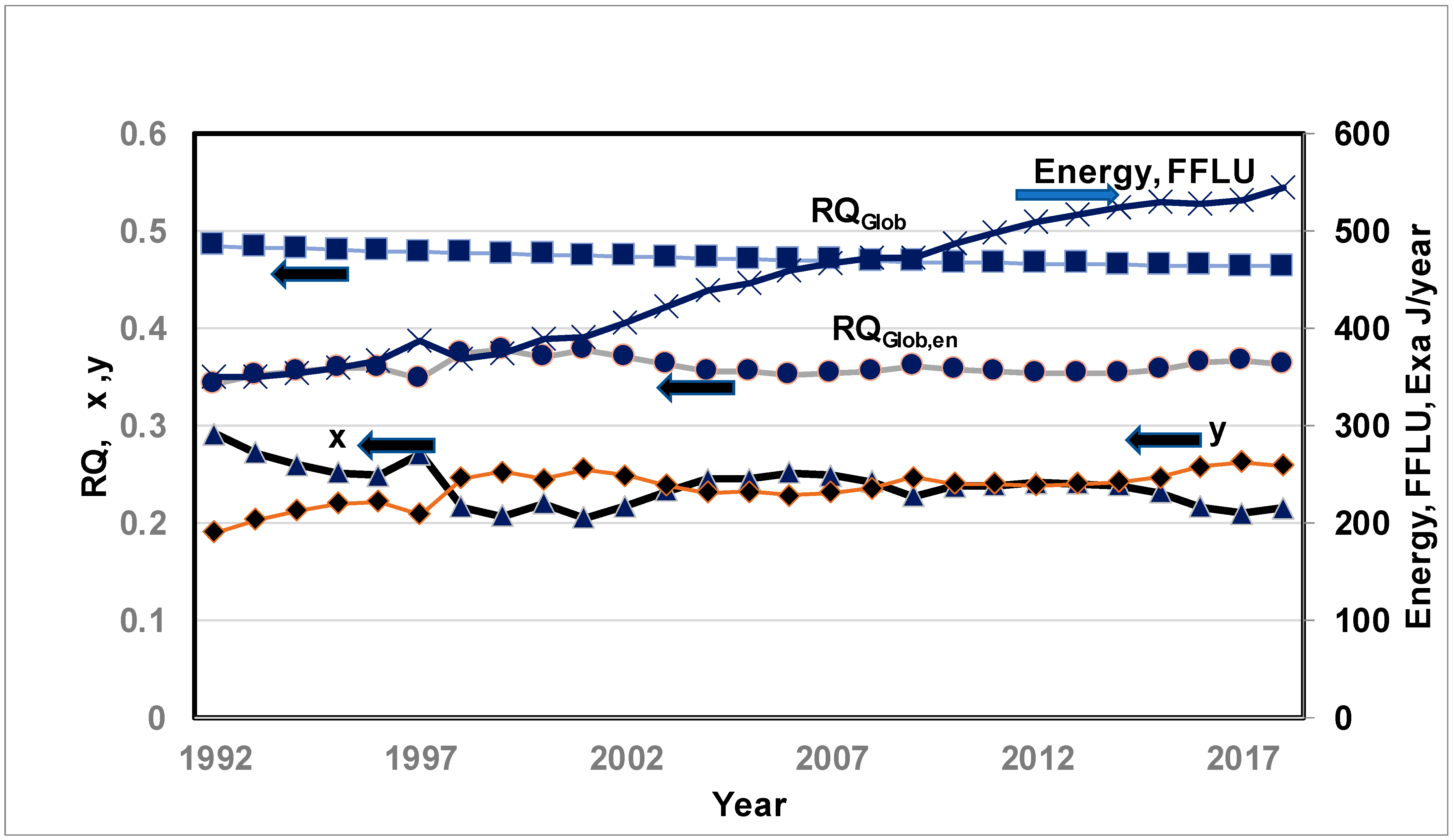



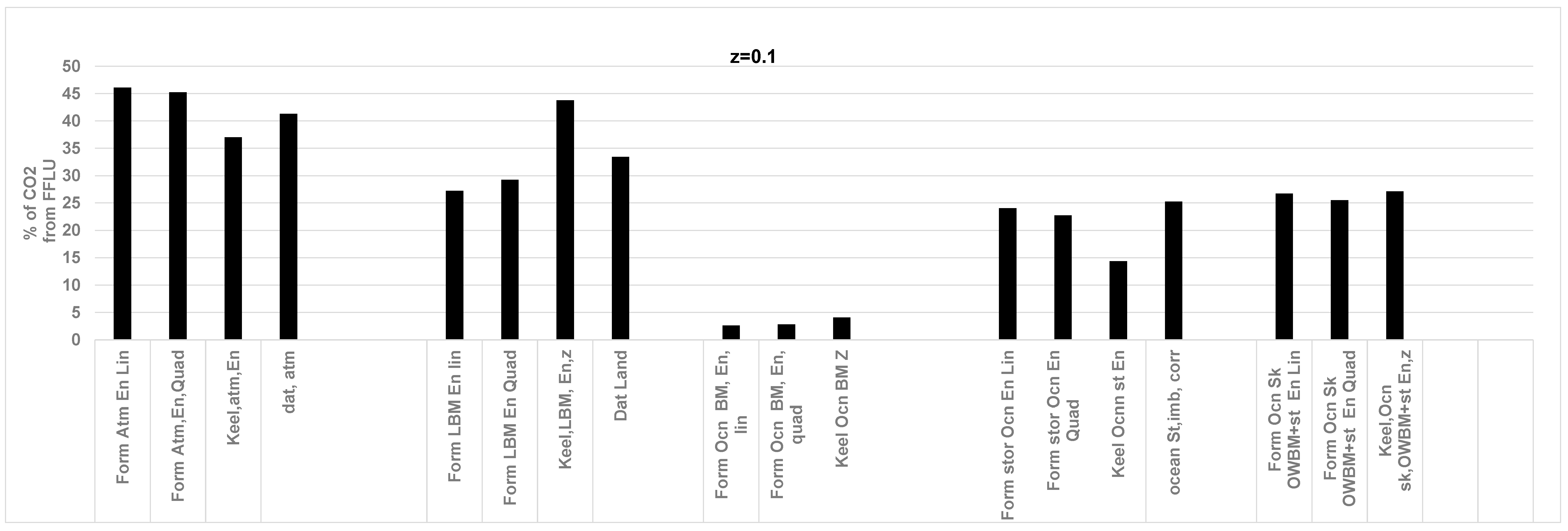
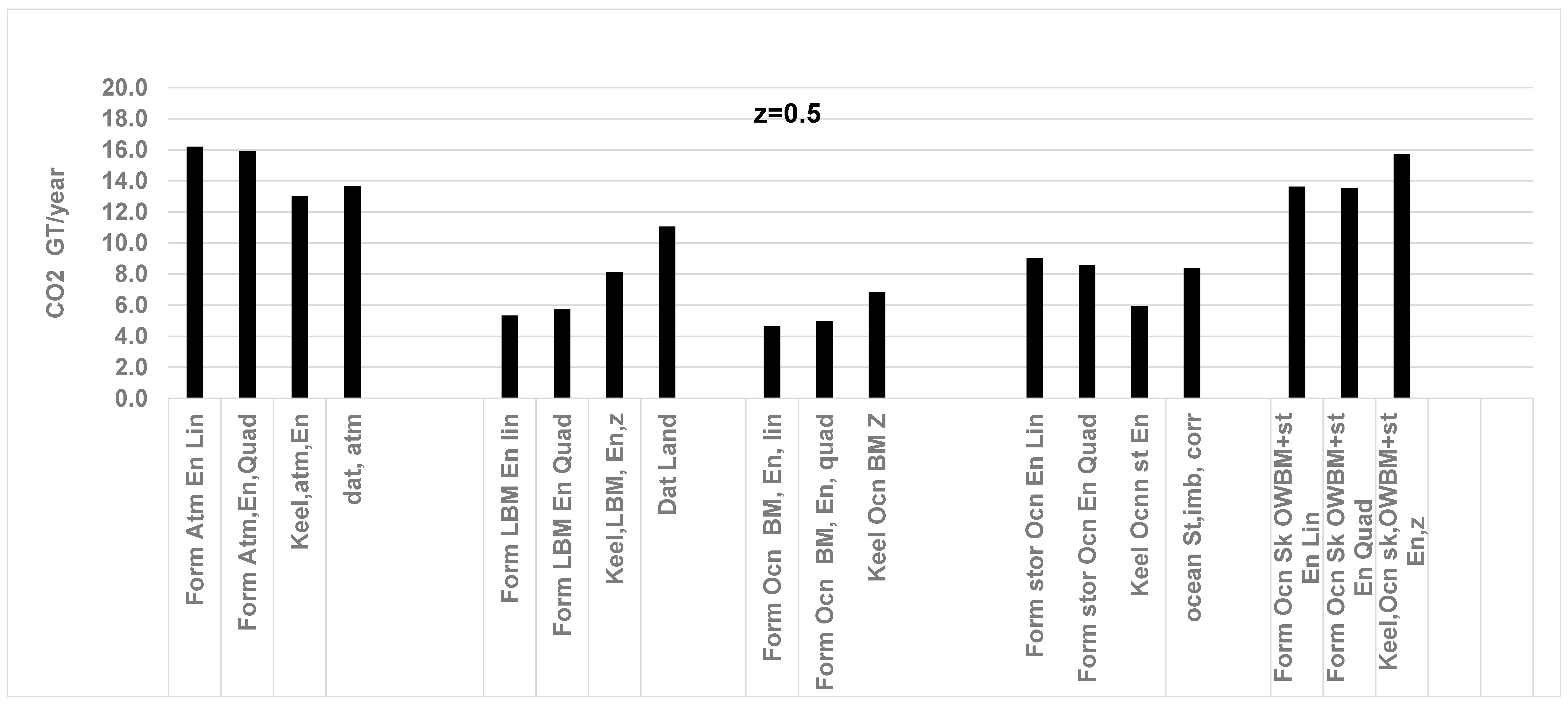
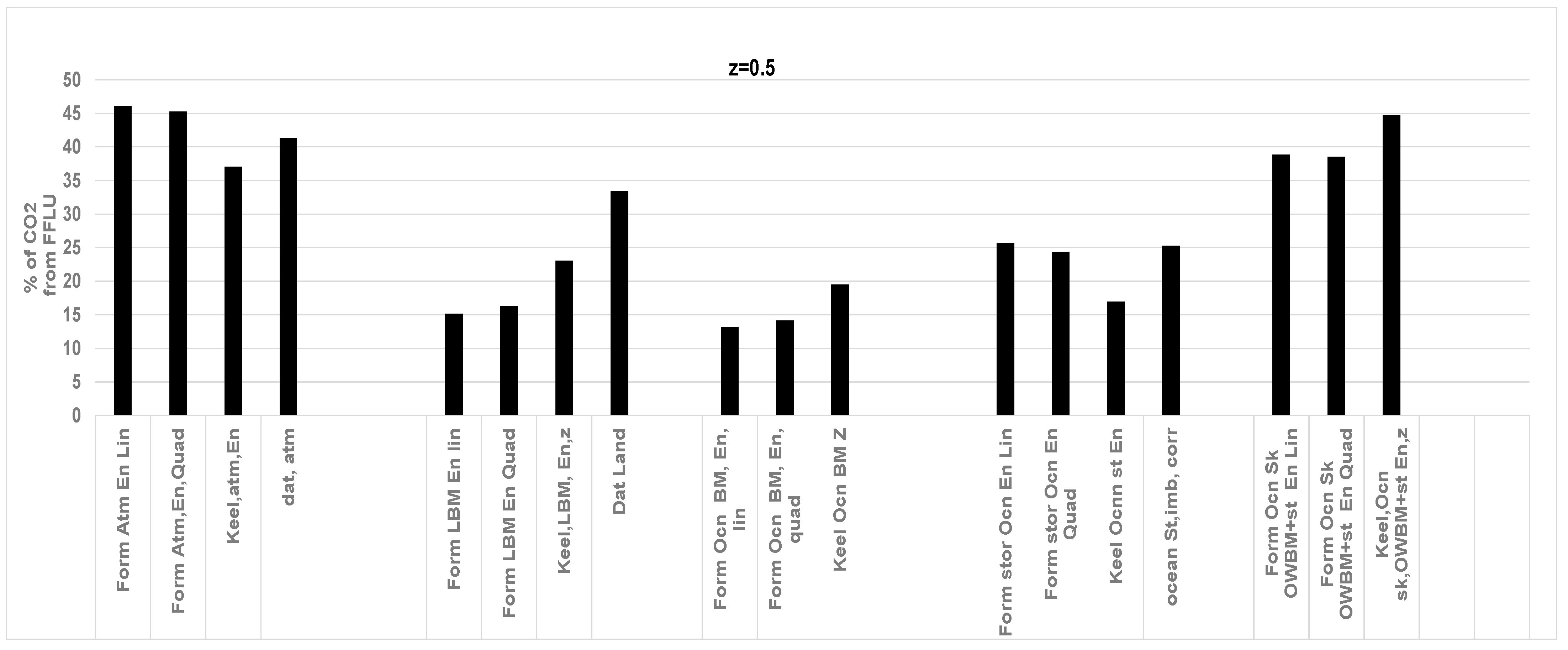
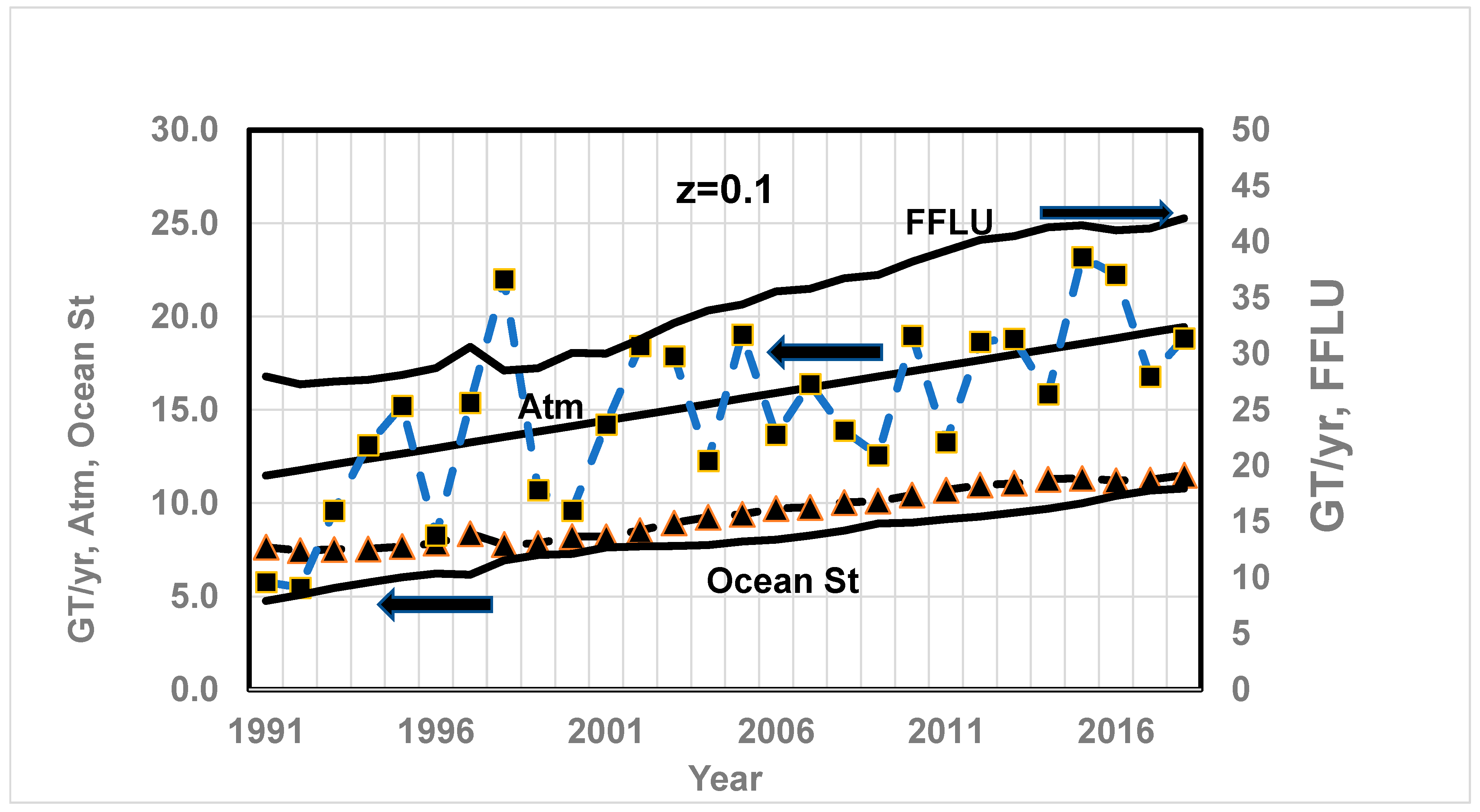
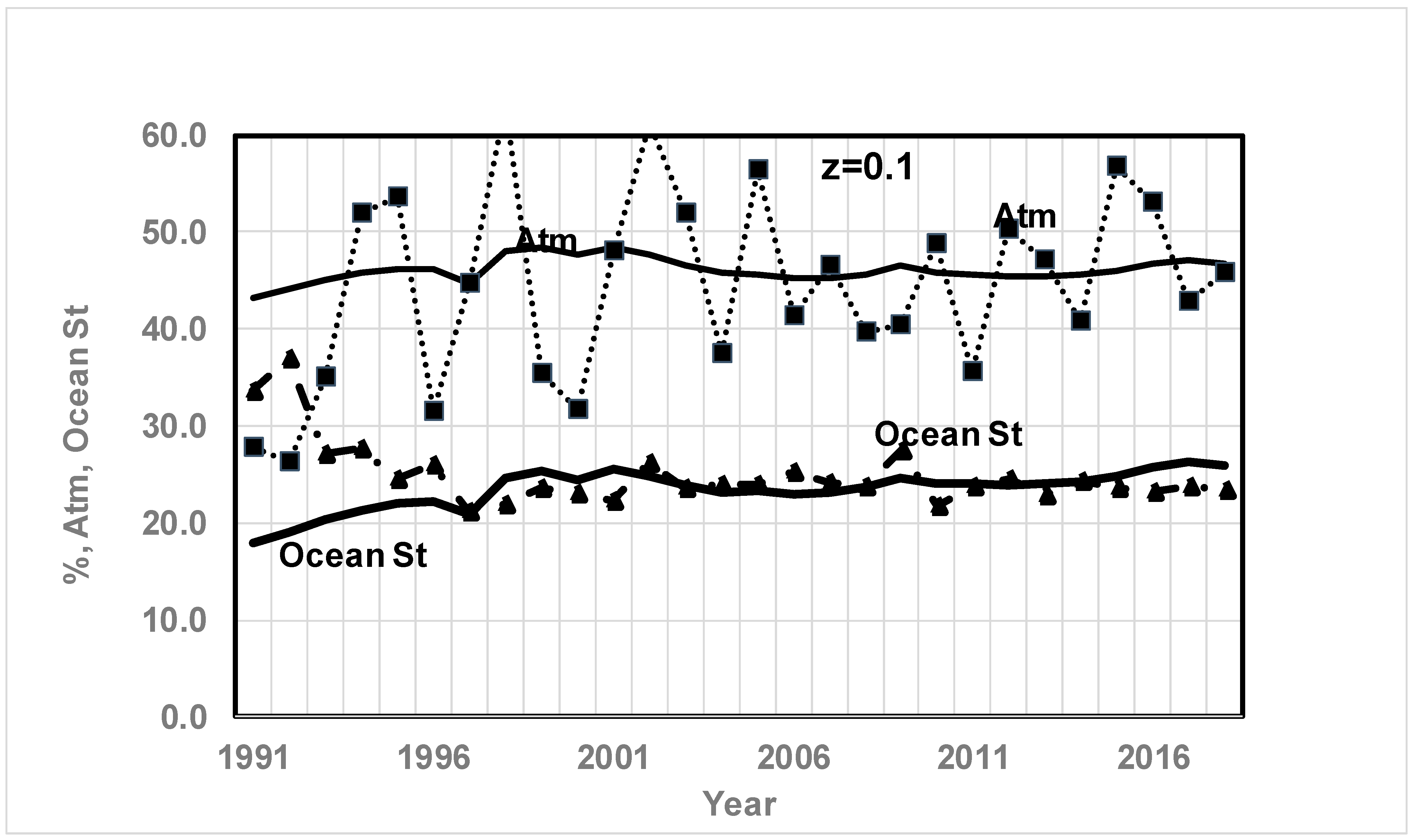
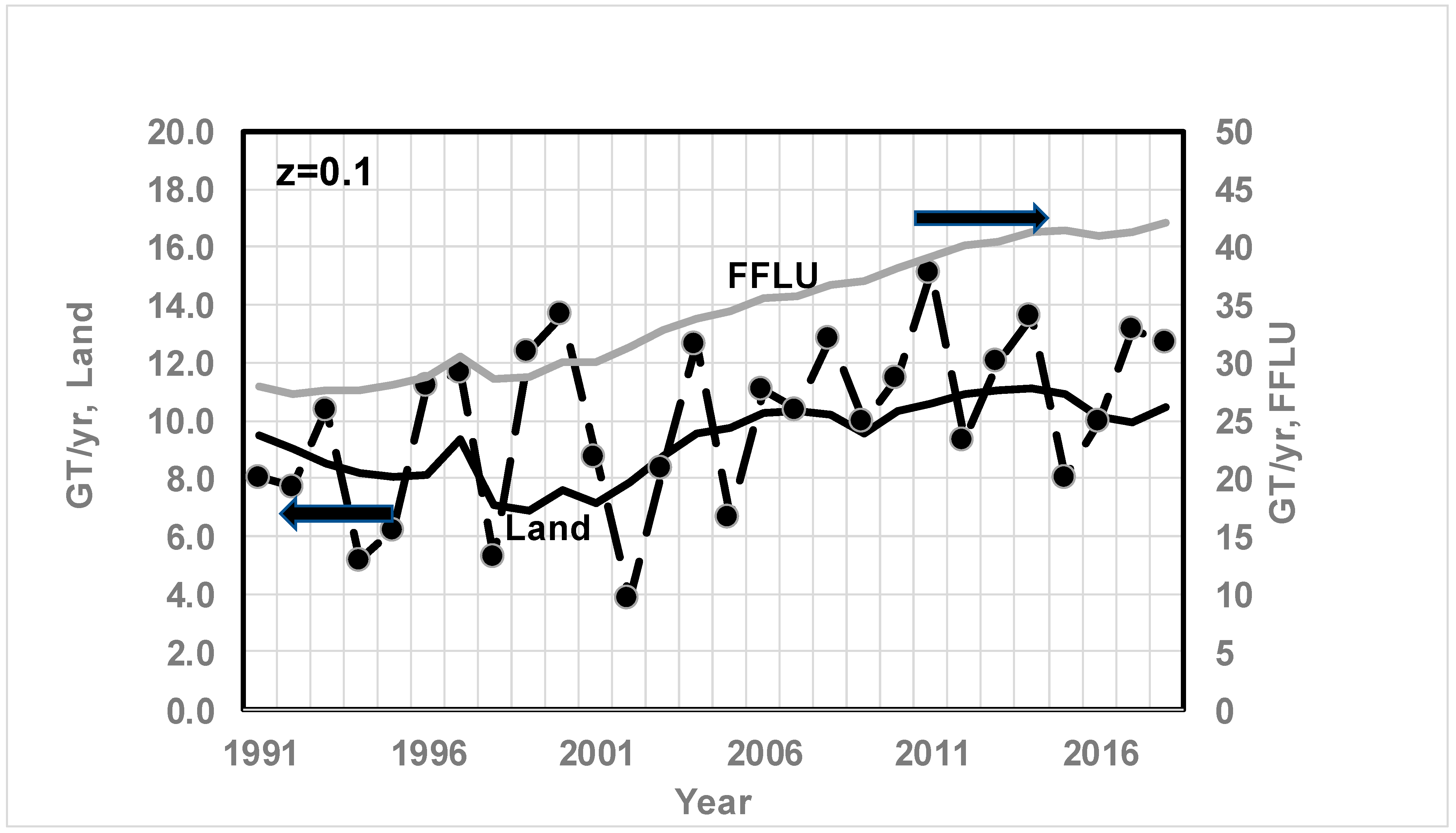
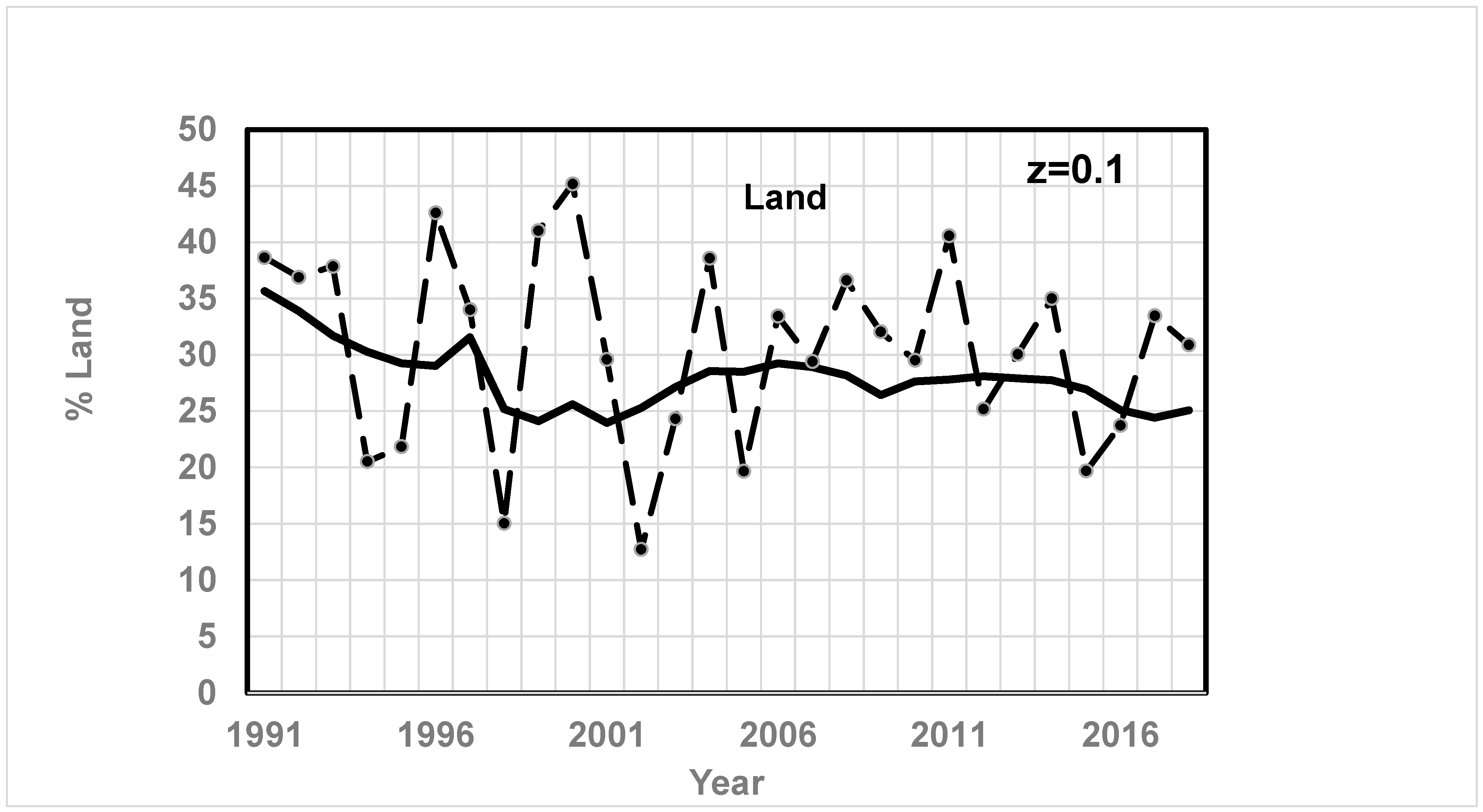
| Air | Ocean Surface | Total Ocean | |
|---|---|---|---|
| N2 | 0.78 | 0.48 | 0.11 |
| O2 | 0.21 | 0.36 | 0.06 |
| CO2 | 0.0004 | 0.15 | 0.83 |
Disclaimer/Publisher’s Note: The statements, opinions and data contained in all publications are solely those of the individual author(s) and contributor(s) and not of MDPI and/or the editor(s). MDPI and/or the editor(s) disclaim responsibility for any injury to people or property resulting from any ideas, methods, instructions or products referred to in the content. |
© 2024 by the author. Licensee MDPI, Basel, Switzerland. This article is an open access article distributed under the terms and conditions of the Creative Commons Attribution (CC BY) license (https://creativecommons.org/licenses/by/4.0/).
Share and Cite
Annamalai, K. Breathing Planet Earth: Analysis of Keeling’s Data on CO2 and O2 with Respiratory Quotient (RQ), Part II: Energy-Based Global RQ and CO2 Budget. Energies 2024, 17, 1800. https://doi.org/10.3390/en17081800
Annamalai K. Breathing Planet Earth: Analysis of Keeling’s Data on CO2 and O2 with Respiratory Quotient (RQ), Part II: Energy-Based Global RQ and CO2 Budget. Energies. 2024; 17(8):1800. https://doi.org/10.3390/en17081800
Chicago/Turabian StyleAnnamalai, Kalyan. 2024. "Breathing Planet Earth: Analysis of Keeling’s Data on CO2 and O2 with Respiratory Quotient (RQ), Part II: Energy-Based Global RQ and CO2 Budget" Energies 17, no. 8: 1800. https://doi.org/10.3390/en17081800
APA StyleAnnamalai, K. (2024). Breathing Planet Earth: Analysis of Keeling’s Data on CO2 and O2 with Respiratory Quotient (RQ), Part II: Energy-Based Global RQ and CO2 Budget. Energies, 17(8), 1800. https://doi.org/10.3390/en17081800







